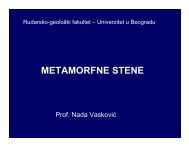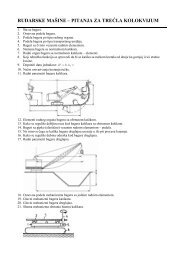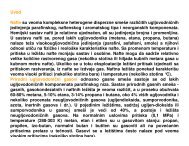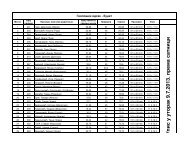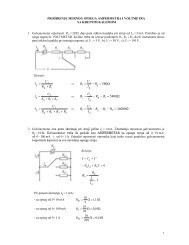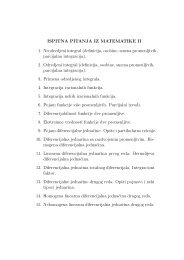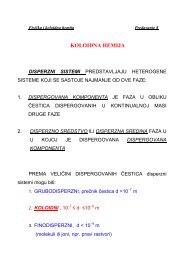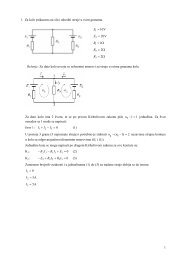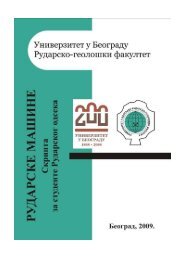KÑига LXXII
KÑига LXXII
KÑига LXXII
Create successful ePaper yourself
Turn your PDF publications into a flip-book with our unique Google optimized e-Paper software.
82<br />
LJUPKO RUNDIĆ, SLOBODAN KNEŽEVIĆ, NEBOJŠA VASIĆ, VESNA CVETKOV & MILOVAN RAKIJAŠ<br />
seawater isotope composition (LATAL et al. 2006;<br />
HARZHAUSER et al. 2007). For this reason, some authors<br />
try to calculate the Paratethyan temperature record<br />
based on the open/closure position of the main gateways<br />
between the Mediterranean, the Indian Ocean, the<br />
Atlantic Ocean, and the Paratethys (KARAMI et al.<br />
2011). They applied an oceanic 4-box model to determine<br />
the temperature, salinity and exchange flows for<br />
the Paratethys and the Mediterranean Sea before and<br />
after closure of the Indian Ocean gateways. They concluded<br />
that closure of the gateways connecting Paratethys<br />
and the Mediterranean to the Indian Ocean had a<br />
great impact on the temperature of the basin’s temperature<br />
as well as on its salinity. Following this model, it<br />
seems that the Badenian predominantly algal and bryozoan<br />
limestone suggests warm-temperature conditions<br />
(17–21°C) in this period (KOVÁČ et al. 2007).<br />
Based on the lithological succession, the geological<br />
and hydrogeological cross-sections and the results of<br />
the infiltration tests, it can be asserted with confidence<br />
that there is no hydraulic connection between the<br />
Mutalj and Beli Kamen Quarries that could have a<br />
significant impact on aquifer recharge.<br />
The paleomagnetic study of the post-Badenian lateritic<br />
clays shows that biogenic limestones and their<br />
products should not be rejected a priori as unsuitable<br />
for paleomagnetism but should be viewed as potential<br />
carriers of the primary RM. The carrier of remanent<br />
magnetization in these clays is magnetite, which<br />
occurs in significant concentrations and probably has<br />
a primary origin. In relation to the Badenian sediments<br />
on the northern slope of FG, which have a positive<br />
RM polarity, they have the opposite RM polarity<br />
and, practically, same values of inclination (CVETKOV<br />
2010; LESIĆ et al. 2007). The declination of the RM is<br />
counter-clockwise rotated, which is typical for Badenian<br />
deposits on FG (LESIĆ et al. 2007), as well as for<br />
other rock masses of the southern part of the Pannonian<br />
Basin (MARTON 2005). On the other hand, the extracted<br />
paleodirection is limited by the Late Pliocene<br />
rotation and the Badenian limestone underlying the<br />
Pontian sediments, hence, it can be concluded that the<br />
mentioned clays formed during the Middle–Late Miocene.<br />
This is contrary to common opinion that they<br />
belongs to the Pleistocene (the Srem Formation, see<br />
PETKOVIĆ et al. 1976)<br />
Conclusions<br />
The Mutalj Quarry is located on the southern slope of<br />
Fruška Gora. It is the largest Miocene quarry in this part<br />
of the mountain. It occupies of 0.3 square kilometer of<br />
a more or less rectangular area and the mean thickness<br />
is more than 40 meters (recent data). The high content<br />
of carbonate (more than 98 %) in the limestones allows<br />
them to be very important raw materials for cement production<br />
(La Farge Cement Factory, Beočin).<br />
Core data, structural and stratigraphic measurements<br />
show that the whole limestone deposit on the<br />
southern slope of FG belongs to a narrow, discontinuous<br />
belt of Middle Miocene Badenian sediments with<br />
E–W extension. In the Mutalj Quarry, the limestone<br />
has the largest distribution and transgressively lies<br />
over the Lower Miocene Vrdnik Formation (up to<br />
date, there is no confident data regarding the precise<br />
stratigraphic position of these rocks). There are no<br />
other Miocene units there. This means that the Middle<br />
Miocene Sarmatian and the whole Upper Miocene are<br />
completely missing. Different Pleistocene sediments<br />
including the red continental beds (the Srem Formation)<br />
and the loess–paleosoil sequences form the<br />
cover of this limestone.<br />
Sedimentological analyses as well as fossil remains<br />
from the limestone indicate to favorable conditions<br />
needed for development of marine, shallow-water assemblages<br />
(mollusks, foraminifers) and reef-forming<br />
organisms, such as red algae, bryozoans, corals, etc.<br />
This indicates to the Badenian marine transgression in<br />
this part of the Central Paratethys. The mostly algal<br />
and bryozoan limestone suggests warm-temperature<br />
conditions (17–21°C). This biogenic, shallow-water<br />
carbonate unit on the Mutalj Open Pit represents the<br />
best section of Leitha limestone on the investigated<br />
area. After the Badenian, a continental regime replaced<br />
this marine one. Due to the drier climate, red lateritic<br />
beds were formed upwards. Additionally, numerous<br />
cracks and caverns within the limestone were<br />
formed. Later, fine-grained prolluvial sediments infilled<br />
them.<br />
The Middle Miocene Badenian limestone provides<br />
a good environment for the formation of karst aquifers.<br />
Analyses of hydrogeological mapping in the<br />
wider area of the Mutalj Open Pit, and data from boreholes<br />
and infiltration tests determined the large permeability<br />
potential of this limestone. The coefficient<br />
of filtration is about K = 10 –2 cm/s, thus they belong<br />
to the highly permeable sediments.<br />
Based on paleomagnetic investigations, it was determined<br />
that the magnetite-bearing sediments deposited<br />
during the post-Badenian time mainly do not carry<br />
a coherent. In relation to the Badenian sediments on the<br />
northern slope of the FG that have a positive RM polarity,<br />
they have the opposite RM polarity. The declination<br />
of the RM is counter-clockwise rotated, which is a<br />
characteristic for Badenian Age (LESIĆ et al. 2007).<br />
However, the extracted paleodirection is limited by the<br />
well known the Late Pliocene rotation. Therefore, it can<br />
be concluded that the mentioned clays probably formed<br />
during the Middle–Late Miocene.<br />
Acknowledgements<br />
We would like to express gratitude to the La Farge Co.<br />
(Beočin, Serbia) for allowing access to their quarries. The



